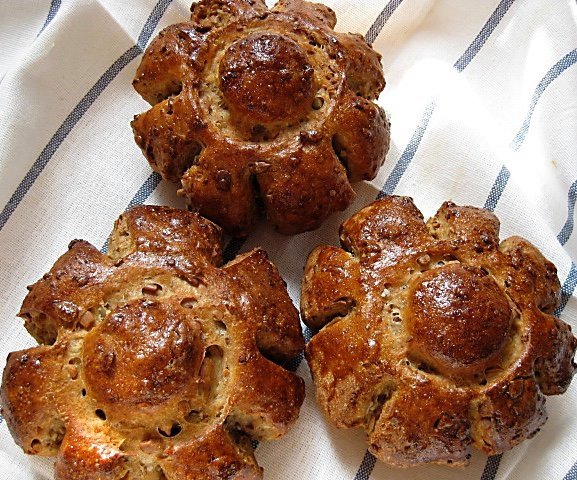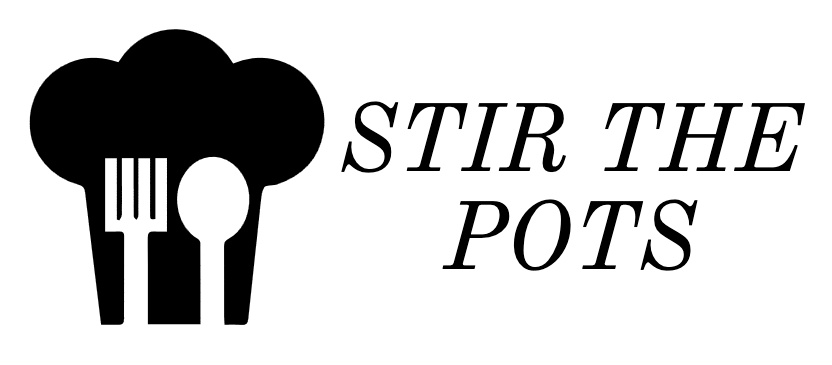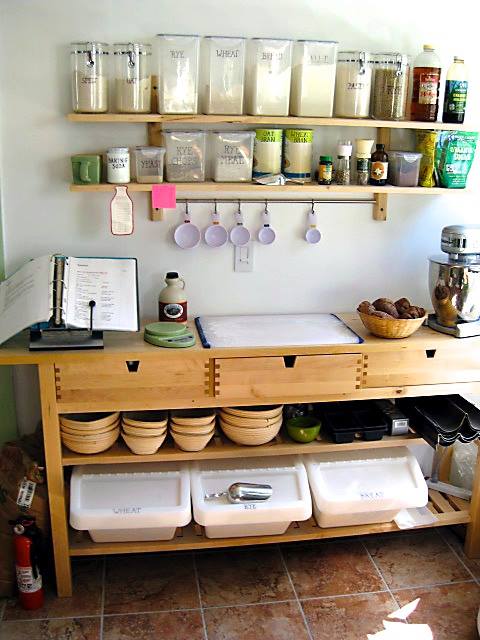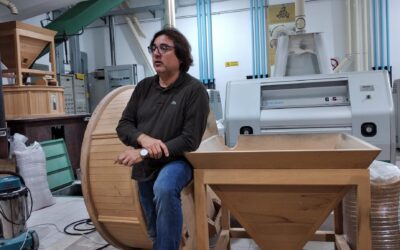Karin Anderson came to me through her daughter. It's a long story. Basically, my brother, Philippe, was head chef at a resort in Colorado. Karin's daughter trained under Philippe working in his kitchen. They became friends. And then I was introduced to Karin's bread blog. A German-born baker now living in Maine, she is someone whom I have come to respect and enjoy. I recently got a chance to interview her but first asked her for a bio. I think her self-description is better than anything I can offer.
After a long and very satisfying career as psychiatrist and neurologist, practicing and teaching psychotherapy in Germany, I moved to Maine in 2001. My American husband used to import container loads of furniture from Northern Europe, so why not adding a wife from Hamburg? Since I retired from my work as psychoanalyst, and our kids are grown up, I had to look for another outlet for my energies, and turned my bread baking hobby into a micro bakery. The baking keeps me entertained and happy, it also resolves the problem what to do with all my output – we are only two people, the cats don’t care for sourdough, and the freezer is full to the gills. My only complaint: So much to bake – and so little time!
And here’s my interview with this interesting woman.
How did you become a baker?
When I relocated from Hamburg/Germany to Maine, there was absolutely no decent bread to be found in our area. A major problem for me, since I love good bread, and my stomach doesn’t accept Wonderbreads. Therefore I had to start baking my own – out of desperation!With my husband as willing guinea pig, I slowly improved my baking skills, until I was happy with the results and felt confident enough to turn my home kitchen into a micro bakery.
What’s your favorite grain?
I can’t say I have a real favorite. I like adding rye, spelt, oat, barley and,more recently, einkorn and other ancient grains to my doughs.
How difficult or easy is it to find grains in Maine?
I purchase organic wheat, rye, spelt and oat flours and grains in bulk from a whole grocer in Lewiston/Maine. An Italian whole sale/retail grocery in Portland supplies me with low-protein Tipo 00 flour for my rolls.
Medium rye and grains that I use less often (like einkorn and other ancient grains) I have to order online.. And medium wheat or spelt (Typ 1050) I sneak into my carry-on when I come back from visits in Germany. How does micro baking differ from a storefront bakery, and how does it work in your community?
Baking from my home kitchen, I have very little overhead costs, and am able to schedule my baking preparations in a way that doesn't interfere too much with my family life. I bake for a local natural food store, depending on the season once or twice a week. They always order my signature rye baguettes and multigrain pitas, but otherwise it’s “baker’s choice”, and therefore the work never gets old! This, and the fact that people really seem to appreciate and enjoy my breads – I have a group of faithful “followers” – is very gratifying (and boosts my ego!).
What sorts of bread did you grow up eating in Germany?
The typical German everyday loaf is a rye/wheat sourdough (Feinbrot or Graubrot). On Sundays we would sometimes have wheat rolls (if somebody would get up early and buy them) and white toast bread. Every evening my father made us eat coarse, 100%-rye Vollkornbrot – I hated it, and it’s still my least favorite bread, even though the ones I bake taste much better than what I remember from my childhood.
Are you using primarily sourdough or mixed hybrid?
For my micro bakery I use mixed hybrid leavens in order to have more reliable rising times. My breads are all made with preferments and/or long overnight fermentation, so that I can keep the amounts of commercial yeast very low.
For my family, when timing is no concern, I often bake pure sourdoughs.
What bread is your tried and true favorite go to loaf?
My rustic rye baguettes with sourdough, a type of Pain a l’Ancienne. I bake them every week for my customers, and always have a supply in the freezer (my husband, the retired furniture dealer, calls them “the nicked and dinged ones”).
My other favorites are whole grain loaves à la Tartine. I like experimenting, and a basic Tartine bread can hold whatever porridge, grain, nut or seed I fancy. (photo: Tartine-like bread with Kamut Porridge)
When you visit Germany, do you visit bakeries for inspiration?
I love visiting bakeries, wherever I go. My favorite fresh market in Hamburg, the Isemarkt, also has several good bread sellers. And Germany probably has the best Turkish bakeries outside of Turkey. Sadly, even in bread country Germany so-called bake shops with their cheap, prefabricated stuff pop up everywhere, and drive many old, from-the-scratch bakeries out of business.
Maine has become the renaissance of grains like other places in the Northeast, do you use local or commercial flours?
I would love to use local flours, but, unfortunately, they are still very hard to come by. The only Maine grown wheat I can get in bulk is non-organic, therefore I can’t buy it for my organic bakery.
Who are your bread heroes?
First and foremost Peter Reinhart. After I mastered a decent German every-day rye, I widened my baking horizon with “The Bread Baker’s Apprentice” and “Whole Grain Breads”.
I still use his pre-dough method for my whole grain breads, and his stretch-and-fold technique (from “Artisan Bread Every Day) for many of the others.
My second bread hero is Richard Ploner, a baker from South Tyrol, whose small book “Brot aus Südtirol” has lots of interesting, unusual recipes. I bake many of his breads regularly – though I adapted them to long fermentation. Chad Robertson from Tartine Bakery inspires me to a never ending line of tartine-esque loaves, in all possible variations.
You blog about your baking. Do you want to write a book?
I’m probably too lazy. I admire people like “brotdoc” Björn Hollensteiner who doesn’t only manage to bake lots of breads (besides his regular work as a family practitioner!), but is a prolific blogger, too. He wrote a wonderful bread baking book, together with Lutz Geissler from ploetzblog, another German heavy-weight baker and blogger.
How do you explain something like sourdough or baker’s percent to budding bakers?
Sourdough is a collaborative of several different strains of wild yeasts and lactic acid bacteria that work together in tandem. The bacteria digest the carbohydrates of the flour, producing carbon dioxide and acetic acid in the process. They are responsible for the good taste of the bread, and, with their acidity, protect the sourdough from other, harmful, microorganisms.
The sourdough yeasts do most of the heavy lifting. They produce lots of carbon dioxide and some alcohol (sourdough always smells a bit alcoholic.) These wild yeasts not only tolerate the acidic environment the bacteria create, they even need it to grow! Therefore a new starter first has to turn sour, before it has any leavening power.
Bakers’ percent is the ratio between the flour (always at 100%) and the other dough ingredients. It helps bakers to multiply or reduce a bread formula, and, also, to estimate whether certain important ingredients like salt, yeast, or the amount of preferment, are within a normal range or off. I often calculated ratios with the Rule of Three – about the only thing I remember from high school arithmetic!
It must have:
- An appetizing smell
- A golden, or dark golden, thin crust – not pale and rubbery like many under-baked supermarket loaves.
- A moist crumb, without gummy areas. Depending on the type of bread denser or airier, but no giant gas bubble under the crust (aka “baker’s bedroom”).
- And, of course, most important: a great taste. A hint of spice is nice, but not an overpowering monopoly of one spice (like caraway in some ryes).
What do you do when you don’t bake?
Blogging in English and in German about breads and pastries. Looking at recipes… Trying not to bore my husband with too much bread talk – unless I want to listen to minute details of classical guitar composition. I also like to read, travel, swim, and chase our cats around (since our ungrateful brood has not yet supplied us with grandchildren!) But I do get withdrawal symptoms if I’m too long away from an oven!
THE END
Karin was kind enough to offer this recipe for one of her “favorite breads.”

SUNFLOWER MINI BREADS (adapted from Richard Ploner) (6 small breads)
307 g bread flour
150 g whole wheat flour
50 g whole spelt flour
6 g instant yeast
340 g water, lukewarm (95ºF)
10 g salt
5 g sugar (1 tsp.)
200 g sunflower seeds, toasted
egg yolk, slightly beaten, for brushing
DAY 1
Dissolve yeast in warm water. Add to all other dough ingredients in mixing bowl. Mix for 1 – 2 minutes by hand or with mixer at low speed, until all flour is hydrated and ingredients come together. Let dough rest for 5 minutes.
Knead dough for 2 minutes at medium-low speed, adjusting with a bit of water as needed, dough should be smoother but still sticky. Continue kneading for another 4 minutes. Dough should be still somewhat sticky.
Prepare a clean, lightly oiled bowl.
Transfer dough to a lightly oiled (or wet) work surface. Lightly oil (or moisten) your hands. Pat and stretch dough into a rough square, then fold it from top and bottom in thirds, like a business letter. Repeat stretching and folding in thirds from left and right.
Place dough ball, sides tucked under, into prepared bowl. Cover, and let it rest for 10 minutes.
Repeat those stretches and folds 3 times, at 10 minute intervals (total time 40 min.) Dough will become smoother, but, with all those seeds, it will be also a bit stiff.
After the last fold, cover bowl, and place into refrigerator for overnight fermentation.
DAY 2
Remove dough from refrigerator 2 hours before using, to come to room temperature.
Preheat oven to 410ºF/210ºC, including steam pan.
Transfer dough to lightly floured work surface, and divide into 6 equal pieces. Shape them into large rolls, and place them, seam side down, on parchment lined baking sheet. Brush breads with egg wash.
Using scissors, make 8 incisions around rim of each bread (see photo). Then, with a small round cookie cutter, press down in the middle to create the flower shape (the breads will spread and flatten a bit). Spray breads lightly with oil, cover, and proof them for 30 – 45 minutes, or until they have grown 1 1/2 times their original size (finger poke test.)
Place breads in oven, steaming with 1 cup hot water (optional), and bake for 12 minutes. Remove steam pan, rotate baking sheet 180 degrees, and continue baking for another 13 minutes, until breads are a deep golden brown, and register at least 200ºF/93ºC (instant thermometer.)
Let breads cool on a wire rack.






Now I feel really important – I hope my ego doesn’t swell too much from all those compliments 🙂
Thanks, Jeremy, for giving me the chance to talk about a subject we both love!
Happy Baking,
Karin